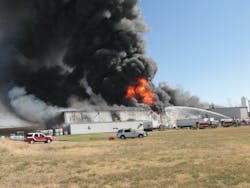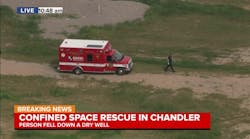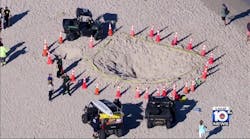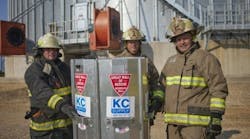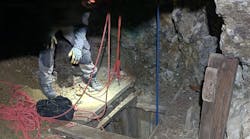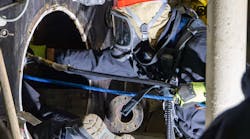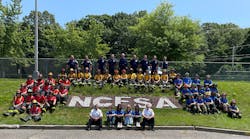On Monday, Oct. 3, 2011, a four-alarm fire in Waxahachie, TX destroyed the Magnablend Industries plant, which manufactured and packaged custom chemicals for a variety of uses, including agriculture feed supplements and oil field, water treatment, construction and industrial cleaning products. It took 120 career and volunteer firefighters from 11 departments more than four hours to control the fire, which investigators determined was caused by a chemical reaction during manufacturing. Concerns about public safety forced the evacuation of 700 to 1,000 people from an elementary school, an assisted living center, an apartment complex and several duplex homes.
The Type II building was 554 feet long and 192 feet wide. It was built about 30 years ago and used by a plastic-pipe manufacturer. A large addition was built 10 years ago and Magnablend purchased the facility about five years ago.
Extra units dispatched
The Waxahachie Fire Department received an automatic alarm from Magnablend at 1601 State Highway 287 Bypass at 10:40 A.M. The department usually sends one engine to an automatic alarm, but at the time of this alarm, employees at Navarro College, next to Magnablend, saw white smoke coming from the plant and reported it the fire department’s administration office. A box alarm consisting of two additional engines, a ladder truck and a battalion chief was added immediately.
Engines 3, 1 and 2 and Ladder 3, a 105-foot aerial ladder, responded under the command of Battalion Chief John Rodgers along with 12 firefighters. Fire Chief David Hudgins, Assistant Fire Chief Randall Potter, Fire Marshal Dennis Crecelius and Battalion Chief Gary Myers also responded.
First-due Engine 3 reported heavy smoke visible while leaving its station a half-mile away. While enroute, Hudgins saw the smoke and requested a second alarm and two mutual aid engines. (In Waxahachie, a second alarm is a callback of off-duty firefighters who live within 10 miles of the city.) Red Oak Fire Department Chief Eric Thompson and Engine 183 and Midlothian Fire Department Deputy Chief Dale McCaskill and Engine 2 responded with eight firefighters.
As Hudgins approached the Magnablend facility, all of the smoke coming from the structure was white and cloud-like. Hudgins said his first impression was that a tank was overheating or having a chemical reaction. As he passed the back of the property, he saw a cherry-red spot about 10 by 10 feet on the metal building’s back wall. Hudgins drove around the building to observe all of its sides. When he returned to the back of the building, fire was coming out from the spot he had seen earlier.
Hudgins established a command post in the plant’s northwest parking area. Rodgers was assigned to the C Division and Potter to the B Division. Engine 2 was directed to connect to the sprinkler system in front of the building and was supplied by a 100-foot, five-inch line. Two 100-foot, 2½-inch lines were connected to the building’s fire department connection. Engine 1 laid a 900-foot, five-inch line to the rear of the building to supply Engine 3, which was setting up for deck gun operations. Engine 1 Captain Don Alexander was advised to establish an unmanned ground monitor just inside an open doorway to cut off the fire from the main building. The monitor was positioned 20 feet inside the building and supplied by 250 feet of three-inch hose from Engine 1, but was not placed into operation due to a closed fire door. Alexander stated there was no fire at that location at that time. Ladder 3 was positioned at the rear of the building behind Engine 3 and set up for aerial master stream operations. Hudgins was advised that a lack of water prohibited both aerial and deck gun operations. The deck gun on Engine 3 was shut down.
Conditions change
The smoke was changing from white to dark black and blowing close to the ground on the north side of the complex, where the building’s sprinkler connection was located. Engine 2 was delayed in connecting to the sprinkler system because the crew needed to don self-contained breathing apparatus (SCBA). Hudgins decided no handlines would be advanced inside the structure due to the heavy volume of fire.
After pumping into the sprinkler system for two to three minutes, Engine 2 Engineer Glenn Morrill noticed the engine’s motor was racing. Morrill realized this indicated a broken sprinkler system in the building. Engine 2 was ordered to evacuate its position and report to the command post. Less than five minutes after the arrival of the fire department, the back wall and roof collapsed in the area of the fire.
At 10:55 A.M., additional mutual aid was requested. Responding units included Emergency Service District 6 Engine 982, Ovilla Fire Department Engine 704, Ennis Fire Department Tower 9, De Soto Fire Department Quint 261, Lancaster Fire Department D351, a decontamination trailer, and the Dallas Fire Department hazardous materials unit. Also, a Waxahachie “all call” was initiated, notifying all off-duty firefighters to report to their duty station regardless of where they live. Engine 982 and crew responded to Waxahachie Station One for standby to provide emergency services to the rest of the city along with off-duty Waxahachie Battalion Chief Randel Muirhead, Captain Jeff Marrs and three firefighters. Two ambulances were assigned to the command post by the East Texas Emergency Medical Center. Ovilla’s rehab truck and the American Red Cross were requested to set up a rehabilitation area at the scene.
Unified command
A unified command was established with Hudgins and Waxahachie Police Chief Chuck Edge, City Manager Paul Stevens and Public Information Officer Amy Hollywood. Edge closed all roads around the incident. Police also evacuated an elementary school, assisted living center, apartment complex, and several duplex homes in the area. These evacuations needed to be completed within 45 minutes. Approximately 700 to 1000 people were evacuated. Waxahachie police were assisted by the Ellis County Sherriff’s Office and Texas Department of Public Safety. Citizens were told to evacuate, but no shelter was provided. The elementary school and the assisted living center both implemented their emergency plans for evacuation.
At 11:10 A.M., as the fire continued to grow in the C Division, the command post was relocated farther to the southwest from the building. No firefighting operations were assigned to the A Division because of the heavy smoke. Waxahachie Engine 2 and Red Oak Engine 183 were reassigned to establish two ground monitors in the D Division. Midlothian Engine 2, Ovilla Engine 704 and Ennis Tower Ladder 9 were assigned to the B Division under Potter’s command. Their assignment was to stop the fire at the loading dock and protect the outside storage area and 10 railcars. Potter placed Ennis Tower Ladder 9 in the loading dock facing the main gate to facilitate a quick exit if needed. Midlothian Engine 2 laid a 300-foot, five-inch line to Ennis Tower Ladder 9. Midlothian firefighters also deployed a ground monitor in front of the loading dock doorway using 150 feet of 2½-inch hose, but time did not allow the monitor to be used. While setting the ground monitor in place, Safety Officer Dale McCaskill noticed radiant heat from the fire was melting the plastic bladders of numerous totes in the building, each tote containing 330 gallons of mineral oil.
Mineral oil ignites
At 11:20 A.M., two Ennis firefighters were elevating Tower Ladder 9’s platform into position. McCaskill and Potter saw the plastic bladder in a tote near the dock doorway rupturing. Everyone was ordered to evacuate the area immediately. Midlothian Engine 2 was quickly moved from the area as Tower Ladder 9’s platform was coming down. The radiant heat ignited the large amount of mineral oil and a wave of fire flowed from the building. Tower Ladder 9’s platform was bedded and the two firefighters exited the bucket just before the wave of fire consumed the apparatus. Potter exited to the north, or A/B Division, corner. All other firefighters exited to the southeast, or the B/C Division, corner. Radio communications could not be established between Potter and the other firefighters, so a personnel accountability report (PAR) was verified via personal cell phones.
Because the B Division was now engulfed in fire, it was separated into A/B and B/C divisions. Potter was assigned as the A/B Division officer and Myers as B/C Division officer. Potter assigned Ovilla Engine 704 to establish deck gun operations from the service road of the main gate into the outside tote-storage area. However, due to the intense heat, the area quickly became untenable. Engine 704 was repositioned down the service road and reassigned to the B/C Division.
C Division deteriorates
At 11:30 A.M., conditions in the C Division continued to deteriorate. Waxahachie Engines 1 and 3 and Ladder 3 were ordered to evacuate their positions and report to the D Division, the only division able to attack the fire directly. Command created an operation division consisting of Rodgers and Thompson. The fire still could not be approached from the A Division because of heavy smoke and the structure could not be reached from the B Division because the fire had engulfed the outside storage area. Access to the C Division was limited by a drainage ditch full of unknown product.
Within five minutes, the fire started to flow into the drainage ditch east of the property, in front of the railcars and toward Navarro College Fire Academy buildings in the B/C Division. De Soto Quint 261 was assigned to the B/C Division and set up for aerial master stream operations on the south side of the fire academy building to cool the railcars and extinguish the fire in the drainage ditch. The Waxahachie Public Works Department was asked for backhoes and dump trucks of dirt to dam and dike the area.
The Dallas hazmat team arrived at the command post at 11:45 A.M. and was assigned to determine the contents of the railcars and take over containment operations. The team continually tested the runoff water for hazardous materials. The Lancaster Fire Department Decontamination Unit set up a decon tent in the far southeast corner on Navarro College property, upwind, but downstream of the fire.
The Ellis County Sheriff’s Office helicopter arrived at 12:20 P.M. and flew Thompson around the incident. Waxahachie Engine 4, a reserve engine manned by off-duty firefighters, and Forreston Engine 1 were assigned to the A/B Division. Engine 4 deployed a ground monitor and Engine 1 used a deck gun to cool railcars on the north end of the property.
After train traffic on the main line was stopped, the ground monitor from Engine 4 was moved atop the rail line to be more effective. The B/C Division knocked down the fire in the ditch and around the railcars. A ground monitor was deployed from Ovilla Engine 704 and De Soto’s quint was reassigned to the A/B Division, inside the main gate and used to extinguish the smoldering fire in the east end of the building and tote-storage area. Off-duty firefighters brought in two Waxahachie brush trucks to extinguish grass fires. Command also requested De Soto’s command vehicle to the scene.
The Texas Commission on Environmental Quality (TCEQ) and the U.S. Environmental Protection Agency (EPA) arrived at the command post about two hours into the fire. Several hours later, the EPA had its plane fly over and into the smoke plume to test the air for contaminants. The TECQ and the EPA also established ground air-monitoring stations in a 360-degree pattern around the fire. Clean-up operations started late in the afternoon with vacuum trucks collecting runoff water.
Under control
Hudgins declared the fire under control at 3 P.M. Command was terminated at 11:15 P.M., but the fire continued to smolder deep in the ruins of the building. Waxahachie firefighters remained on scene 24 hours a day until 5 P.M. on Friday, Oct. 7, to verify that the small spot fires did not ignite any chemicals on the property.
No firefighter or civilian injuries were reported from this incident. While Magnablend Industries’ loss was catastrophic, no adjacent business suffered any damage. The damage estimate exceeds $10 million. Ennis Tower 9, a 1988 Sutphen TS 100 aerial tower, was destroyed in the fire. The department expects delivery of a new 100-foot aerial ladder in February.
Ennis Chief David Hopkins said, “Training means a lot,” as it took only 30 seconds after firefighters were off the truck for the flames to engulf it. “The guys on the platform couldn’t see through the doors of the plant, but the captain did and had them come down. They thought they would have time to lift the outriggers and drive it out, but they didn’t.”
The Waxahachie Fire Department Fire Marshal’s Office investigated the fire. The cause was determined to be a chemical reaction during a manufacturing process involving a product used by water treatment facilities. This product had been manufactured at least 16 times in batches of 500 gallons or less, but this was the first time it was mixed using a 2,500-gallon batch. The product produced a hydrogen gas steam cloud that overwhelmed the ventilation system and was ignited from an electric motor or a light bulb breaking.
All clean-up operations continue to be under the supervision of the EPA and TECQ. Water used on the fire was collected and transported off-site for disposal. Clean-up of contaminated soil is ongoing and it will ultimately be disposed of in a landfill.
